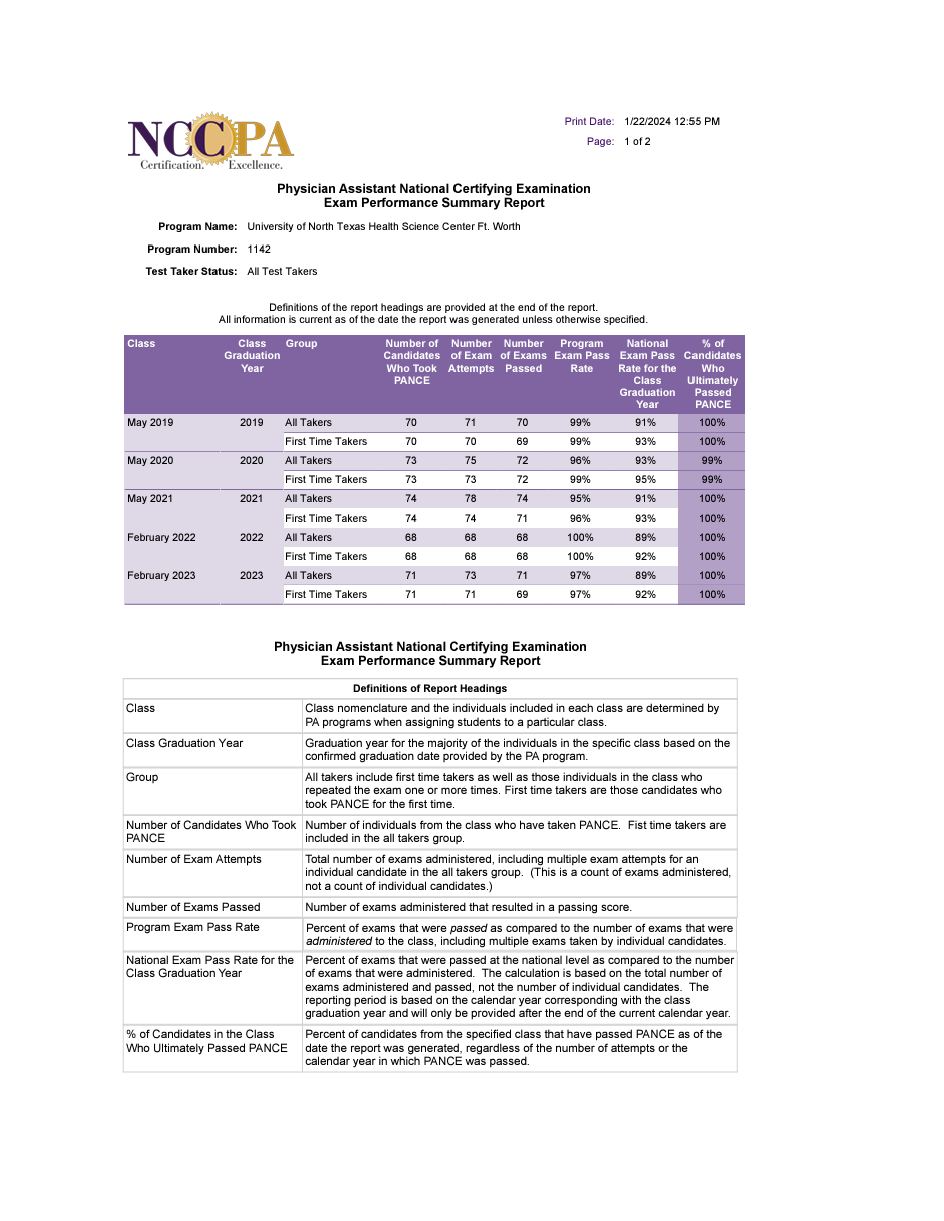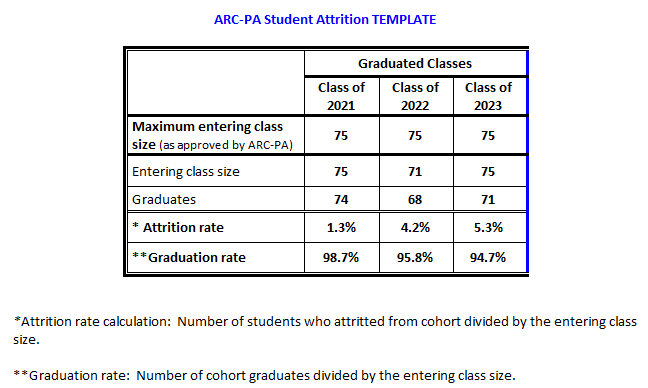Physician Assistant Studies
Located for more than twenty years in the heart of the Fort Worth, Texas, Cultural district, our HSC at Fort Worth Physician Assistant Program has proudly helped shape the PAs that make a difference in our community. We are continually improving as we create Experiential Learning opportunities that prepare our graduates to begin an exciting medical career in one of the top professions in the country. Our graduate performance on the national certifying exam is exceptional and underscores our commitment to true Interprofessional Education. We teach beyond written exams giving our learners the hands-on confidence to truly be outstanding health care providers.
About Our Program
The Department of Physician Assistant Studies is the academic home for students and faculty involved in the Master of Physician Assistant Studies (MPAS) degree curriculum. Upon successful completion of the curriculum, graduates receive an MPAS degree. The MPAS curriculum prepares students for entry into clinical practice as a physician assistant.
US News and World Report magazine has ranked our program in the top 13th tier of graduate-level physician assistant programs in the Nation.
We provide students with an environment that is both conducive to learning the art and science of medical practice and to helping our students achieve individual growth as healthcare professionals.
Our program was first established in 1997. Today, our program is housed within the School of Health Professions.
Accreditation
The Accreditation Review Commission on Education for the Physician Assistant (ARC-PA) has granted Accreditation-Continued status to the University of North Texas Health Science Center Physician Assistant Program sponsored by the University of North Texas Health Science Center. Accreditation-Continued is an accreditation status granted when a currently accredited program is in compliance with the ARC-PA Standards.
Accreditation remains in effect until the program closes or withdraws from accreditation process or until accreditation is withdrawn for failure to comply with the Standards. The approximate date for the next validation review of the program by the ARC-PA will be September, 2024. The review date is contingent upon continued compliance with the Accreditation Standards and ARC-PA policy. The UNTHSC program’s Accreditation Actions History can be accessed on the ARC-PA website.
Forty-eight states and The District of Columbia Physician Assistant and/or Medical Licensure Boards recognize the Masters of Physician Assistant Studies Degree from an Accreditation Review Commission on Education for the Physician Assistant (ARC-PA) accredited physician assistant program as fulfilling the academic requirements for PA licensure. Minnesota and North Dakota do not require the degree, but do require passage of the PA National Certification Examination (PANCE) produced by the National Commission on Certification of Physician Assistants (NCCPA). Applicants must graduate from an ARC-PA approved PA program to be eligible to take the PANCE. The ARC-PA, maintains national accreditation standards for physician assistant programs. The UNTHSC PA program is ARC-PA accredited and program graduates are eligible to take the PA National Certification Examination after successfully completing the program.
Mission Statement
The mission of the Program is to create solutions for a healthier community by preparing graduates with knowledge and skills needed for physician assistant practice, emphasizing primary care medicine and meeting the healthcare needs of underserved populations.
Program Goals
Program Goals 2024
Goal 1: Graduates will demonstrate knowledge needed for PA Practice by achieving acceptable mean scores on the PANCE.
| Benchmarks | Cohort | |||
| 2021 | 2022 | 2023 | ||
| UNTHSC pass rates for first-time takers on the PANCE will meet or exceed the national mean. | UNTHSC Mean | 96% | 100% | 97% |
| National Mean | 93% | 92% | 92% | |
Goal 2: Graduates will contribute to solving the healthcare workforce needs.
| Benchmarks | Cohort | |||
| 2020 | 2021 | 2022 | ||
| 90% or more of our alumni respondents will report working in at least one clinical position as a PA since graduation. | 96% | 100% | 100% | |
| 75% or more of alumni respondents will report working in Texas as a PA 12 months after graduating. | 84% | 66% | 85% | |
| Alumni employment in primary care and underserved/rural practice will meet or exceed the national employment in those areas | UNTHSC Employment | 41% | 31% | 29% |
| National Employment | 30% | 29% | 26% | |
Goal 3: Students will demonstrate professional behaviors for clinical interactions in the PA program.
| 100% | Cohort | |||
| 2022 | 2023 | 2024 | ||
| 90% or more of students will achieve a maximum score (4/4) for professional behaviors during simulated clinical interactions in the didactic phase of the PA program. | 96% | |||
| Average Preceptor ratings of students will exceed 95% (4.75/5) on all items related to professional behavior. | 99% | 98% | 100% | |
| 100% of students will "meet expectations" on all items related to Professional Behavior on the Summative OSCE. | 100% | 100% | ||
Goal 4: Students and alumni will report satisfaction in the quality of the PA program.
| Benchmarks | Cohort | |||
| 2020 | 2021 | 2022 | ||
| 90% or more of current students will rate the program quality as “meets” or “exceeds” their expectations. | Not Obtained* | 97% | 94% | |
| 90% or more of graduating students will rate the program quality as “meets” or “exceeds” their expectations. | 97% | 94% | 87% | |
| 90% or more of alumni will rate the program quality as “excellent” or “good”. | 98% | 91% | 90% | |
| * Due to COVID-19 Pandemic, Student Satisfaction Survey not administered spring 2020. | ||||
PANCE Pass Rates

Attrition Rates

Health and Technical Standards
All students enrolled in the Physician Assistant Studies Program curriculum must meet certain health and technical standards in order to fully participate in the educational programs contained in the curriculum.
Expected Physician Assistant Competencies
Expected Physician Assistant Competencies
Medical Knowledge
- Apply knowledge of anatomy, physiology, pathophysiology, genetics and molecular mechanisms of disease to medical conditions
- Create a pharmacologic treatment plan suitable to the acuity of the condition
- Construct a patient-specific disease prevention plan that emphasizes lifestyle choices, complementary and alternative treatment options, screening recommendations, and disease prevention
- Interpret current and credible sources of medical information
Interpersonal skills
- Utilize effective communication skills to establish therapeutic relationships with patients, their families, and support systems
- Provide effective patient-centered education
- Communicate professionally within the interprofessional healthcare team
Clinical Skills
- Obtain a thorough patient history
- Perform a thorough physical examination
- Present a patient encounter in an organized and concise manner to other healthcare professionals
Technical Skills
- Accurately document the full scope of a clinical encounter that satisfies requirements for medical, legal, quality and financial purposes
- Perform clinical procedures with technical accuracy
Clinical Reasoning & Problem Solving
- Differentiate normal from abnormal physical exam findings as part of the clinical decision-making process
- Utilize all available clinical information to develop and refine a differential diagnosis
- Interpret diagnostic study results as part of the clinical problem-solving process
- Utilize available clinical and patient information to create a patient-management plan
- Determine patient disposition with regard to both the clinical setting, patient situation, and need for referral/consultation
Professional Behaviors
- Perform as a dependable member of the interprofessional healthcare team
- Treat all patients equally
Societal Responsibility
- Communicate to diverse patient populations with cultural humility and responsiveness
- Identify social determinants that contribute to healthcare disparities
Cost of Attendance

To see a breakdown of Cost of Attendance (COA), tuition and fees, click here.
The COA is based on anticipated enrollment of 10 credit hours for summer, 20 credit hours for fall, and 20 credit hours for spring. The Cost of Attendance (COA) is an estimate of a student’s educational expenses. Since the COA is based on average costs, your actual expenses may be different. To help determine your actual tuition and fee charges, you can view the Tuition and Fee Link at
https://www.unthsc.edu/tuition-and-fees/
*The COA is based on anticipated enrollment of 18 credit hours for fall, and 18 credit hours for spring.
**The COA is based on anticipated enrollment of 10 credit hours for summer, 20 credit hours for fall, and 20 credit hours for spring.
***The COA is based on anticipated enrollment of 10 credit hours for summer, 18 credit hours for fall, and 18 credit hours for spring.
All fees are subject to change.
Graduation Requirements
Requirements for Graduation
Students who have met all course requirements and have been recommended for graduation may be awarded the Master of Physician Assistant Studies (MPAS) degree provided they meet all of the conditions listed below:
- Have satisfactorily completed all academic requirements of the Physician Assistant Studies Program
- Have complied with all legal and financial requirements of the University of North Texas Health Science Center at Fort Worth.
- Have exhibited the ethical, professional, behavioral, and personal characteristics necessary for practice as a PA.
- Have completed and returned to the Physician Assistant Studies Program or the Office of the Registrar all graduation forms and paperwork required by the Physician Assistant Studies Program and the institution.
- Have met other time limits listed below:
-
- The maximum time limit for completing all graduation requirements is seventy-two (72) months.
- Rarely, students may be required to meet additional requirements to meet other health science center, state, or national regulations.
Students who do not fulfill all graduation requirements by the day of graduation will not be allowed to participate in commencement ceremonies without permission of the Dean (or designee). Students will not be considered graduates in any capacity until they have successfully completed all graduation requirements.

Social media